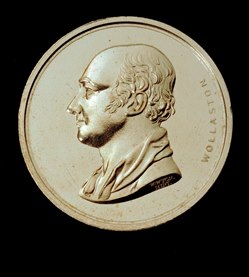
As we look forward to the Awards Ceremony on June 6, Marie Edmonds* reports on an Awards Committee review of the Society’s medals and awards.
The Society’s Awards and Medals are a valuable way of honouring the achievements of individuals and groups in the geoscience community. Recently, they have been comprehensively reviewed and updated, to allow proposers to understand more clearly the categories, eligibility and criteria for each.
This year we also have a new gong: the Dewey Medal, named for Professor John Dewey FRS, which will be awarded for excellence in geological fieldwork. Furthermore, our Specialist Groups offer a raft of awards and prizes that are given annually (some of which involve cash). Nominating someone for one of these Awards is easy and will really make a difference to them. This is how the process works.
Who’s Wolly?
Of the Society’s ‘career achievement’ awards, the Wollaston Medal ranks highest. The Wollaston (above, right) was established by William Hyde Wollaston (1766-1828), an eminent figure in British science credited with discoveries across the natural sciences. The Medal, originally of gold, is now of palladium, a metal Wollaston himself discovered. The Medal was intended to promote ‘researches concerning the mineral structure of the Earth’ …‘or of the science of Geology in general’. Its first recipient was William Smith (1831). The first woman to receive it was palaeo-oceanographer Professor Maureen Raymo, of Lamont-Doherty Earth Observatory, Columbia University, in 2014.
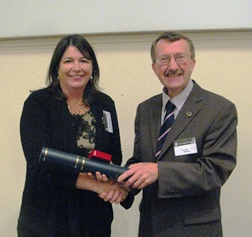 Right:
Right: Professor Maureen Raymo receiving the Wollaston Medal in 2014. Photo: Ted Nield.
The Lyell, Murchison and William Smith trio of medals, as well as the Prestwich Medal (established under the will of Sir Joseph Prestwich, 1812-96), are held in high regard and considered equally prestigious. They are awarded to geoscientists who have made sustained and excellent contributions to their fields by means of a substantial body of work through their careers in academic, applied or economic geoscience. The Lyell is normally given for contributions to ‘soft’ rock studies and the Murchison for ‘hard’ rock. The William Smith Medal is awarded for contributions to applied or economic aspects.
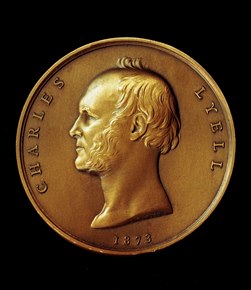
These medals are named for distinguished geoscientists who were among the founders of our science. The Lyell (left) was established under the will and codicil of Sir Charles Lyell (1797 – 1875), the author of Principles of Geology. The Murchison Medal was established under the will of Sir Roderick Impey Murchison (1792-1871), author of Silurian, Permian and Devonian Systems. The William Smith Medal is named for so-called ‘father of English geology’ the maker of the first geological map of Britain and arguably the pioneer of applied geology.
The Sue Tyler Friedman Medal is awarded for distinguished contributions to History of Geoscience. In 2013, for example, it was awarded to Henry Robert (Hank) Frankel, of the University of Missouri-Kansas City, who wrote the definitive account of the evolution of ideas that led from continental drift to plate tectonics: The Continental Drift Controversy (2012 - in four volumes).
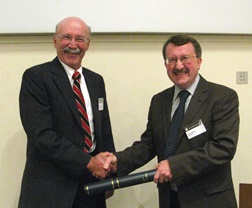
Right: Hank Frankel receives the Sue Tyler Friedman Medal in 2013
The Society is delighted to introduce the Dewey Medal, to be awarded on President’s Day (6 June). The Dewey Medal is named for Professor John Dewey FRS, who has held positions as Professor of Geology at Durham, Oxford and UC Davis. Prof Dewey is a structural geologist who has made important contributions to understanding the history of the Appalachians as well as the Scottish and Irish Caledonides, and the development and orogenic history of the Himalayas. The Medal is to be awarded annually to a geologist who has made ‘substantial and significant contributions to geology through sustained field mapping and/or field observation of rocks, and who has a strong record of training, leading and encouraging others to practise and pursue advances in geology by this means’.
Left: The new Dewey Medal
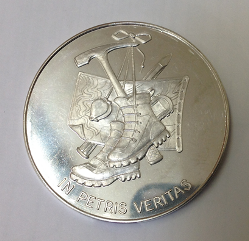 Mid and Early career
Mid and Early career
At a mid-career level, we have the Bigsby and Aberconway Medals. The former has the intriguing description of ‘early career’ as being someone who must have done no more than 25 years’ FTE research, and is ‘thus probably not too old for further work, and not too young to have done much’. The Aberconway recognises distinction in the practice of applied or economic geoscience and was established by a donation from ECC International Ltd. and its chair Charles Melville McLaren (1913-2003), 3rd Baron Aberconway.
Early career geoscientists are a particular focus for the Society’s awards. The four Funds, (Wollaston, Lyell, Murchison and William Smith), celebrate the achievements of geoscientists no more than 10 years from the award of their first degree. Receiving awards at this career stage enhances promotion prospects as well as raising profile, in both research-focused and more applied fields. Presidents may make their own discretionary awards. The President’s Awards (typically two per ye
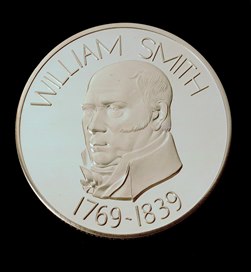
ar) are conferred on individuals within five years of their first degree ‘who show significant early promise and are judged to have potential to be future leaders in their fields’, and come with a cash prize.
Right: William Smith Medal
Unsung heroes
There are some within the community who deserve special honour – those who run essential services, work quietly in the background, or go beyond the call of duty in areas of administration, teaching or policy, all in the name of geoscience. For such worthy but otherwise unsung individuals, or groups, the Distinguished Service Award was established in 1998.
In 2017, for example, this Award was given to Dr Richard Hinton, of the University of Edinburgh, in recognition for dedicating a large part of his career to the provision, support, and continued development of a world-class ion microprobe facility in the UK: the NERC-funded Edinburgh Ion Microprobe Facility.
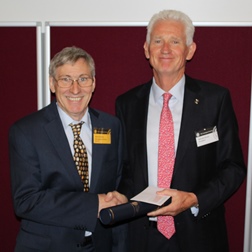
Left: Dr Richard Hinton receiving the Distinguished Service Award in 2017. Photo: Ted Nield.
The R H Worth Award is conferred in recognition of achievements in outreach, public engagement and/or education carried out by an individual or an institution. It was established in 1955 under the will of Richard Hansford Worth. In 2017 it was awarded to Rotunda – The William Smith Museum of Geology, Scarborough, which plays a leading role in introducing the interested public to geology via excursions, talks, fossil-handling sessions, open days, school, university and geological group visits. In 2016 this Award was given to Mr Paul Denton of the British Geological Survey, for his role in the ‘School Seismology’ Programme.
It’s the real thing
The Coke Medals are more properly titled the Major John Sacheverell A'Deane Coke and Major Edward D'Ewes Fitzgerald Coke Medals. These Awards are made to geoscientists for their contributions to science, in addition to significant service to geoscience - for example through administrative, organisational or promotional activities resulting in benefits to the community. The awards may be made to scientists whose training and interests lie outside the main fields of geoscience, but whose contributions are of great significance. These two medals are named in honour of two sons of Lt. Col. Basil Elmsley Coke’s (1884-1970) cousin, who both died at the Battle of Arnhem (1944). In 1965, Lt. Col. Coke, a Fellow of the Society, established an endowment fund for his daughter, with the instruction that after her death the Geological Society was to become the beneficiary - which it did, in 1982.
The list goes on
Specialist Groups of the Geological Society have their own Awards and Medals, typically given out at their Annual General Meetings. The British Sedimentological Research Group, for example, has the Perce Allen Award for a substantial body of research in any field of sedimentology, the Roland Goldring Award for noteworthy published research in any field of sedimentology within 10 years (FTE) of the commencement of their research career, and the Harold Reading Medal for the best publication by a current or recent postgraduate student (normally within two years of doctoral award) from a PhD project in the field of sedimentology and stratigraphy.
The Glossop Award and Glossop Lecture (the latter accompanied by a medal) are the most prestigious of the Engineering Group’s awards. Rudolph Glossop (1902 - 1993) was Chairman of the Engineering Group (1965-68) and Vice President of the Geological Society (1969). The Award is given annually to an outstanding Early Career engineering geologist or geo-environmentalist.
- For more information on the other awards given out by the 22 Specialist Groups of the Society, see the website.
Nominate!
The nomination process is straightforward. The deadline for 2019 awards is 28 September 2018. Download and fill out the correct nomination form here, where you will also find guidance notes, which explain the process in full - including the requirements for proposers and seconders. Note that if the nomination is made by a Specialist Group of the Society, only the Chair’s signature is required on the form. President’s Awards require merely a letter, preferably with CV, to the President - describing the achievements and qualities of the proposed recipient.
Author
* Dr Marie Edmonds (University of Cambridge) is the Society’s Science Secretary and ex officio member of the Awards Committee. E: Marie Edmonds